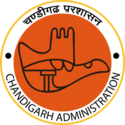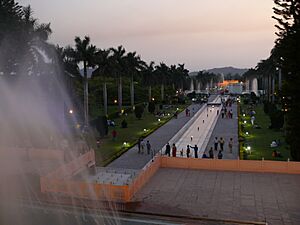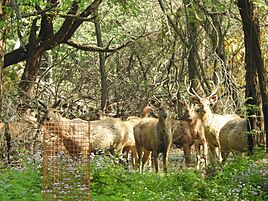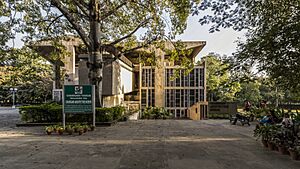Chandigarh facts for kids
Quick facts for kids
Chandigarh
|
|||||||||||||||||||||
|---|---|---|---|---|---|---|---|---|---|---|---|---|---|---|---|---|---|---|---|---|---|
|
Clockwise from top:
Palace of Assembly; Sector 42 Stadium; Rock Garden of Chandigarh; Chandigarh IT Park; Gandhi Bhawan at Panjab University; Open Hand Monument |
|||||||||||||||||||||
|
|||||||||||||||||||||
| Nickname(s):
The City of Beauty
|
|||||||||||||||||||||

Location of Chandigarh in India
|
|||||||||||||||||||||
| Country | |||||||||||||||||||||
| Formation | 7 October 1953 | ||||||||||||||||||||
| Capital | Chandigarh | ||||||||||||||||||||
| Districts | 01 | ||||||||||||||||||||
| Government | |||||||||||||||||||||
| • Body | Government of Chandigarh | ||||||||||||||||||||
| National Parliament | Parliament of India | ||||||||||||||||||||
| • Rajya Sabha | N/A | ||||||||||||||||||||
| • Lok Sabha | 1 seat Manish Tewari |
||||||||||||||||||||
| High Court | Punjab and Haryana High Court | ||||||||||||||||||||
| Area | |||||||||||||||||||||
| • Total | 114 km2 (44 sq mi) | ||||||||||||||||||||
| Area rank | 35th | ||||||||||||||||||||
| Elevation | 321 m (1,053 ft) | ||||||||||||||||||||
| Population
(2011)
|
|||||||||||||||||||||
| • Total | |||||||||||||||||||||
| • Rank | 31 | ||||||||||||||||||||
| • Density | 9,262/km2 (23,990/sq mi) | ||||||||||||||||||||
| • Urban | 1,025,682 (51st) | ||||||||||||||||||||
| Demonym(s) | Chandigarhian | ||||||||||||||||||||
| Language | |||||||||||||||||||||
| • Official | English | ||||||||||||||||||||
| GDP | |||||||||||||||||||||
| • Total (2023–24) | |||||||||||||||||||||
| • Rank | 25th | ||||||||||||||||||||
| • Per capita | |||||||||||||||||||||
| Time zone | UTC+05:30 (IST) | ||||||||||||||||||||
| ISO 3166 code | IN-CH | ||||||||||||||||||||
| Vehicle registration | CH | ||||||||||||||||||||
| HDI (2017–2018) | |||||||||||||||||||||
| Literacy (2023) | |||||||||||||||||||||
| Sex ratio (2011) | 818♀/1000 ♂ (34th) | ||||||||||||||||||||
|
|||||||||||||||||||||
Chandigarh (/ˌtʃʌndɪˈɡɑːr/) is a cool city and a union territory in northern India. It's special because it serves as the shared capital for two states: Punjab and Haryana. You can find it near the foothills of the Himalayas.
Chandigarh is famous for being one of the first planned cities in India after it gained independence. It's known around the world for its amazing architecture and city design. A famous Swiss-French architect named Le Corbusier created the main plan for the city. He built on ideas from earlier architects like Maciej Nowicki and Albert Mayer.
Many of the government buildings and homes were designed by a team led by Le Corbusier, Jane Drew, and Maxwell Fry. In 2016, the Chandigarh Capitol Complex was even named a World Heritage Site by UNESCO. This means it's a very important place globally!
Chandigarh has grown a lot since it was first built. It has also helped nearby cities like Mohali and Panchkula grow. Together, these three cities have a population of over 1.6 million people. Chandigarh also has one of the highest incomes per person in India. In 2015, a survey even called it the happiest city in India!
Contents
- What's in a Name?
- A City's Story: Chandigarh's History
- Chandigarh's Location and Weather
- People of Chandigarh
- Chandigarh's Economy
- Culture and Fun
- Getting Around Chandigarh
- Learning in Chandigarh
- Sports in Chandigarh
- Places to Visit
- Why Chandigarh is Important for Modern India
- Famous People from Chandigarh
- Villages in Chandigarh
- See also
What's in a Name?
The name Chandigarh comes from two words: Chandi and Garh. Chandi refers to the Hindu goddess Chandi. Garh means fortress.
So, the name comes from the Chandi Mandir, an old temple dedicated to Goddess Chandi. This temple is located near the city in the Panchkula District.
Chandigarh is also called "The City of Beauty." This nickname comes from the "City Beautiful movement." This was a popular idea in city planning in North America during the late 1800s and early 1900s.
A City's Story: Chandigarh's History
When India was divided in 1947, the old province of Punjab was split. One part went to India (East Punjab), and the other went to Pakistan (West Punjab). The capital city, Lahore, ended up in Pakistan.
India's first Prime Minister, Jawaharlal Nehru, wanted a brand new, modern city to be the capital of Punjab. So, in 1949, an American planner named Albert Mayer was asked to design this new city, Chandigarh. The government took land from about fifty villages to create it.
Albert Mayer planned a city with large blocks and green spaces. He focused on separate neighborhoods and ways to keep traffic flowing smoothly. However, Mayer stopped working on the city after his partner, Matthew Nowicki, died in a plane crash in 1950.
Then, Le Corbusier took over. He used many of Mayer's ideas. Le Corbusier designed many important buildings, like the High Court, the Assembly, and the Secretariat. He also planned how the city would be divided into different "sectors."
Chandigarh is home to the largest of Le Corbusier's famous Open Hand sculptures. It stands 26 meters tall! The Open Hand was a symbol for Le Corbusier. It meant "peace and reconciliation." He said it was "open to give and open to receive."
The capital officially moved to Chandigarh on September 21, 1953. India's first president, Rajendra Prasad, formally opened the city on October 7, 1953.

During the city's construction, some ancient artifacts from the Indus Valley Civilisation were found. This shows that people lived in this area a very long time ago!
On November 1, 1966, the state of Punjab was split again. The Punjabi-speaking part became the current state of Punjab. The Hindi-speaking areas became Haryana. Chandigarh was right on the border of these two new states. Both states wanted Chandigarh as their capital.
However, the central government decided that Chandigarh would be a union territory. This means it is controlled directly by the central government. It would serve as the shared capital for both Punjab and Haryana until a final decision could be made.
Before Chandigarh was built, this area was also home to a small kingdom in the late 1700s. It had a small fort at Mani Majra. Many old villages still exist within or near the modern city today.
Chandigarh's Location and Weather
Where is Chandigarh?
Chandigarh is located at the foothills of the Shivalik Hills, which are part of the Himalayas. It's in northwest India and covers about 114 square kilometers. The city borders the states of Punjab and Haryana.
It's mostly flat, fertile land. Some nearby cities include Mohali, Panchkula, and Ambala. Chandigarh is about 250 km (156 miles) north of Delhi.
Chandigarh's Climate
Chandigarh has a climate with very hot summers and mild winters. It also gets rain at certain times of the year. Temperatures can range from below freezing (−1 °C or 30.2 °F) in winter to very hot (45 °C or 113.0 °F) in summer. The city gets about 1,110.7 millimetres or 43.73 inches of rain each year.
Sometimes, it rains in winter due to weather systems from the Mediterranean Sea. Cold winds from the snowy Himalayas can make winters chilly.
Here's a quick look at the seasons:
- Spring (late February to mid-April): Temperatures are mild, between 13 to 20 °C or 55.4 to 68.0 °F (high) and 5 to 12 °C or 41.0 to 53.6 °F (low).
- Autumn (late September to mid-November): Temperatures are pleasant, usually between 10 and 22 °C or 50.0 and 71.6 °F.
- Summer (mid-April to mid-June): It gets very hot, often reaching 43 °C or 109.4 °F.
- Monsoon (mid-June to mid-September): The city gets moderate to heavy rainfall.
- Winter (late November to late February): Winters are mild but can be cold. Temperatures are usually between 5 to 14 °C or 41.0 to 57.2 °F (high) and −1 to 5 °C or 30.2 to 41.0 °F (low).
Chandigarh is also ranked as one of the cleanest air cities in India!
Wildlife and Nature
Chandigarh has many banyan and eucalyptus trees. You can also find Ashoka, cassia, and mulberry trees. The forests around the city are home to many animals and plants. You might see deer, sambars, parrots, woodpeckers, and peacocks.
Sukhna Lake attracts many ducks and geese. In winter, birds from Siberia and Japan visit the lake. The Parrot Bird Sanctuary Chandigarh is a special home for many parrots. The Sukhna Wildlife Sanctuary became a protected area in 1998.
Heritage Trees of Chandigarh
Some trees in Chandigarh are so old and special that they are called "Heritage Trees." The city government has listed 31 trees as Heritage Trees. These are trees that are 100 years old or more.
Beautiful Landscapes
Sukhna Lake is a 3 square kilometer artificial lake. It was made in 1958 by building a dam on a seasonal stream.
Chandigarh is known for its many green parks and gardens. The Rock Garden is near Sukhna Lake. It has amazing sculptures made from recycled waste materials.
The Zakir Hussain Rose Garden is Asia's largest rose garden! It has almost 825 types of roses and over 32,500 other plants. Other gardens include the Garden of Fragrance, Butterfly Park, and the Japanese Garden. There's also the Government Museum and Art Gallery, Chandigarh.
People of Chandigarh
Population Facts
As of 2011, Chandigarh had about 1,055,450 people. This means it's quite crowded, with about 9,252 people per square kilometer.
More males live in Chandigarh than females. For every 1,000 males, there are 818 females. The city has a high literacy rate of 86.77%, meaning most people can read and write.
The population growth has slowed down a lot. This is probably because nearby cities are also growing fast. Most people (97.25%) live in the city, with only a small number in villages.
Languages Spoken
English is the official language of Chandigarh. However, most people speak Hindi (67.76%). Punjabi is spoken by 22.02% of the people. Schools use English, Hindi, and Punjabi textbooks.
Religions in Chandigarh
| Religion in Chandigarh (2011) | ||||
|---|---|---|---|---|
| Religion | Percent | |||
| Hinduism | 80.71% | |||
| Sikhism | 13.11% | |||
| Islam | 4.87% | |||
| Christianity | 0.83% | |||
| Others | 0.4% | |||
Hinduism is the main religion in Chandigarh, followed by over 80% of the people. Sikhism is the second largest religion, followed by Islam.
There are many places of worship throughout the city. These include the historic Mata Basanti Devi Mandir. Chandi Mandir and Mata Mansa Devi Mandir are also important Hindu temples nearby. Nada Sahib Gurudwara is a famous Sikh place of worship. There are also old mosques in Manimajra and Burail.
Chandigarh's Economy
Chandigarh is known as one of India's "Wealthiest Towns." It has a high average household income. The city's total economic output for 2014–15 was about ₹290 billion (US$4.3 billion).
In 2014, Chandigarh was ranked 4th among the top 50 cities globally for "emerging outsourcing and IT services."
The Rajiv Gandhi Chandigarh Technology Park, also called the Chandigarh IT Park, is a special area for information technology companies. This park has greatly helped the city's economy grow, especially in the services sector.
Jobs in Chandigarh
The government is a big employer in Chandigarh. This is because the Chandigarh Administration, Punjab government, and Haryana government all have their offices here. Many people in Chandigarh work for these governments or are retired from government service. This is why Chandigarh is sometimes called a "Pensioner's Paradise."
There are also about 15 medium to large industries. Plus, over 2,500 small businesses are registered here. Important industries include paper making, metal work, and machinery. Other industries make food products, auto parts, and electrical items.
Many people work in trade and business. The Punjab and Haryana High Court and the Post Graduate Institute of Medical Education and Research (PGIMER) also offer many job opportunities.
Big companies like Infosys, TechMahindra, and Airtel have offices in Chandigarh and nearby areas. This is because Chandigarh has good infrastructure, is close to other states, and has many skilled IT workers.
Culture and Fun
Festivals and Celebrations
Every year, in September or October, during the festival of Navratri, many groups hold a Ramlila event. This has been happening for over 50 years!
The Rose Festival is held every February in the Zakir Hussain Rose Garden. It shows off thousands of types of roses.
The Chandigarh Carnival is a big annual event held in late November. It includes fun activities, stalls, and cultural programs.
The Mango Festival happens during the monsoons. Other festivals are held at Sukhna Lake. Traditional Punjabi festivals like Lohri and Vaisakhi are also celebrated with great excitement.
Getting Around Chandigarh
Road Travel
Chandigarh has many vehicles for its size. The roads are wide and well-kept, with plenty of parking. The Chandigarh Transport Undertaking (CTU) runs public buses from its main bus stations. CTU also has frequent bus services to nearby states like Punjab, Haryana, and Delhi.
Chandigarh is well-connected by road to nearby cities through national highways:
Air Travel
Chandigarh Airport has regular flights to major cities in India. A new international terminal was finished in 2015. International flights to Dubai and Sharjah have also started. The runway is in Chandigarh, but the terminal is in Mohali.
Train Travel
The Chandigarh Junction railway station is part of the Indian Railways network. It connects Chandigarh to most parts of India. The station also serves the nearby town of Panchkula. There were plans for a metro rail system, but these plans were stopped in 2017.
Learning in Chandigarh
Chandigarh has many schools and colleges. These include both private and public institutions. Some well-known ones are Panjab University, Post Graduate Institute of Medical Education and Research (PGIMER), and Punjab Engineering College.
The Chandigarh education department says there are 115 government schools. There are also many private schools like Bhavan Vidyalaya and Delhi Public School.
Chandigarh has also become a popular place for students to prepare for the IAS exams. Many students from nearby states come here for coaching. They choose Chandigarh over Delhi because of its good living conditions and quality teaching.
Sports in Chandigarh
The Sector 16 Stadium has hosted several international cricket matches. While the PCA Stadium in Mohali is now more prominent, Sector 16 Stadium still helps local cricketers practice and play.
The Chandigarh Golf Club has an 18-hole course. It's known for its challenging design.
Places to Visit
Chandigarh has many fun places to visit:
Nature and Gardens
- Rock Garden of Chandigarh
- Zakir Hussain Rose Garden
- Japanese Garden, Chandigarh
- Parrot Bird Sanctuary, Chandigarh
- Sukhna Lake
- Sukhna Wildlife Sanctuary
- Rose Festival (Chandigarh)
- Heritage Trees of Chandigarh
- Terraced Garden
Museums and Art
- Government Museum and Art Gallery, Chandigarh
- Gandhi Bhawan, Chandigarh
- Open Hand Monument
Famous Buildings
- Open Hand Monument
- Palace of Assembly, Chandigarh
- Chandigarh Capitol Complex
Other Attractions
- Sector-17, Chandigarh (a popular shopping and business area)
- Chandi Mandir (a temple)
- Elante Mall (a large shopping mall)
Why Chandigarh is Important for Modern India
A New Beginning
When Jawaharlal Nehru visited Chandigarh in 1952, he said it should be "a new town, symbolic of the freedom of India." He wanted it to show India's hope for the future, free from old traditions. Chandigarh was meant to be a fresh start for the nation after British rule and the division of India and Pakistan.
Building Chandigarh was a way for India to heal and move forward. The site was chosen carefully. Many existing towns were considered, but Chandigarh was picked because it was safe, could handle many people, was close to Delhi, and had good land and beautiful nature.
Modern Design for a Modern Nation
Chandigarh became a symbol of modern India. It was meant to help the country grow economically and socially. After the British left, India faced challenges like people moving from villages to cities and poverty. Chandigarh, along with other new cities, was built to help with these problems.
These "urban utopias" (ideal cities) tried to bring new national policies to different regions. Chandigarh was the first city built with government money to be a modern, planned city. It aimed to show that modern ideas could help free people through new technology and easier ways to build things like dams and schools.
Le Corbusier's modern architectural style was a clear break from British colonial buildings. This new style influenced many Indian architects and helped create a unique "Chandigarh architecture." Houses were designed to be cost-effective and use natural ventilation, fitting the local climate. This helped form India's new cultural identity in city design.
In 2024, an exhibition in London called Tropical Modernism: Architecture and Independence featured designs for Chandigarh.
Some Criticisms
Some people have criticized Chandigarh's design. They say that focusing only on Le Corbusier ignores the ideas of many other people who helped build the city. They argue that the city's design mainly served the interests of a Western-influenced Indian middle class. This might have overlooked the diverse cultures of India.
Some critics also say that Le Corbusier didn't pay enough attention to Indian preferences when designing homes. They suggest that residents had to change things to fit their usual way of life. However, others argue that the simple, modern style was important for setting new standards for city living across the country.
Famous People from Chandigarh
- Peepal Baba, environmentalist
- Sarbjit Bahga, architect and author
- Binny Bansal, co-founder of Flipkart
- Sachin Bansal, co-founder of Flipkart
- Neerja Bhanot, brave flight attendant
- Sabeer Bhatia, founder of Hotmail
- Jaspal Bhatti, famous actor and satirist
- Abhinav Bindra, Olympic gold medalist
- Nek Chand, creator of the Rock Garden
- Surveen Chawla, Punjabi film actress
- Gurleen Chopra, Punjabi actress
- Vivek Dahiya, actor
- Harita Kaur Deol, pilot
- Kapil Dev, former Indian international cricketer
- Ishaan Dhawan, TV actor
- Harmeet Dhillon, American lawyer
- Yami Gautam, Indian film actress
- Mahie Gill, Indian actress
- Sandesh Jhingan, Indian professional footballer
- Mamta Joshi, Sufi singer
- Gurbani Judge, MTV India VJ and actress
- AJ Kanwar, dermatologist
- Kirron Kher, Indian actress and politician
- Aparshakti Khurana, Indian film actor
- Ayushmann Khurrana, Indian film actor
- Rochak Kohli, music composer
- Sargun Mehta, Punjabi film actress
- Anjum Moudgil, Indian rifle Shooter
- Prince Narula, actor
- Gul Panag, Indian film actress and social activist
- Neel Kamal Puri novelist
- Gajendra Pal Singh Raghava, bioinformatics scientist
- Kulraj Randhawa, Punjabi film actress
- Mohinder Singh Randhawa, civil servant who helped establish Chandigarh
- Harnaaz Sandhu, winner of Miss Universe 2021
- Mohit Sehgal, TV actor
- Piare Lal Sharma, writer
- Jeev Milkha Singh, professional golfer
- Milkha Singh Commonwealth gold medalist
- Yuvraj Singh, Indian international cricketer
- Pammi Somal, Bollywood journalist
- Sri Srinivasan, United States Circuit Judge
- Manan Vohra, cricketer
- Hitendra Wadhwa, professor
- Kashmiri Lal Zakir, Indian poet and writer.
Villages in Chandigarh
- Khuda Jassu
See also
 In Spanish: Chandigarh para niños
In Spanish: Chandigarh para niños



































